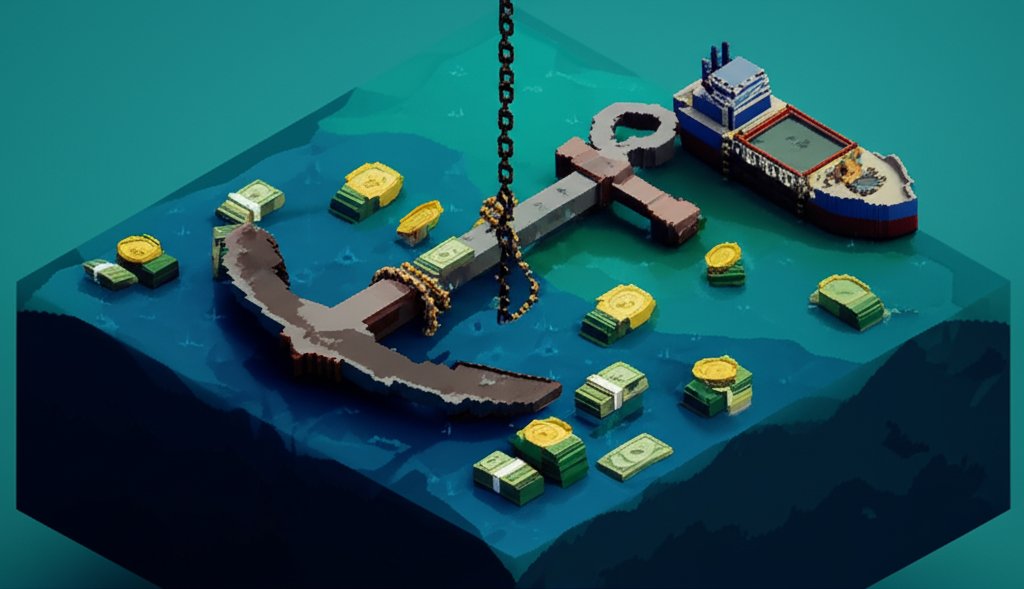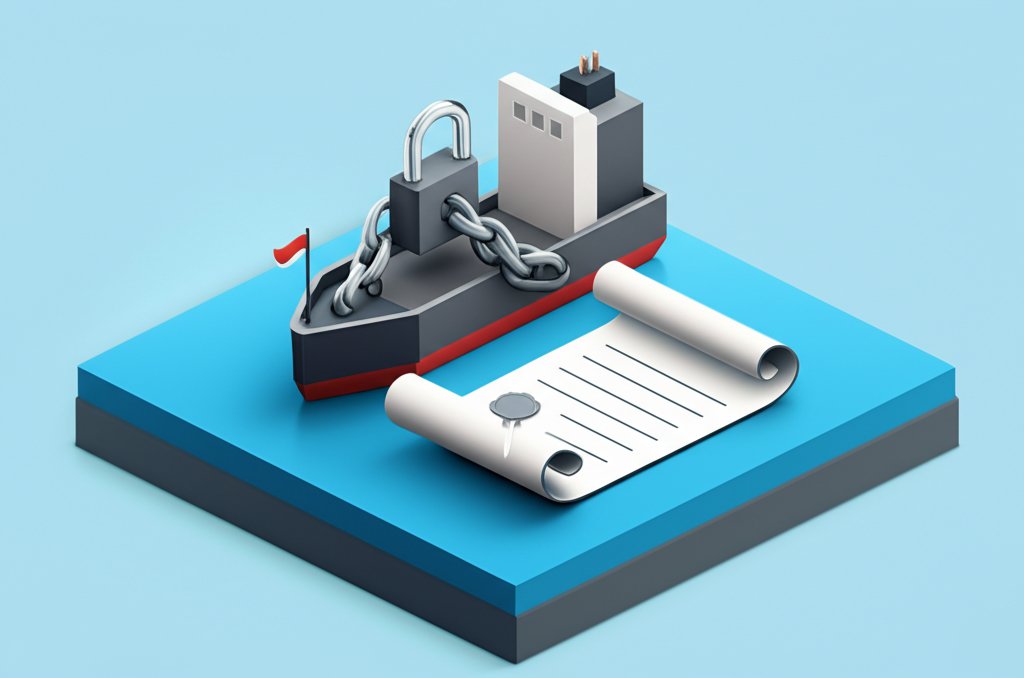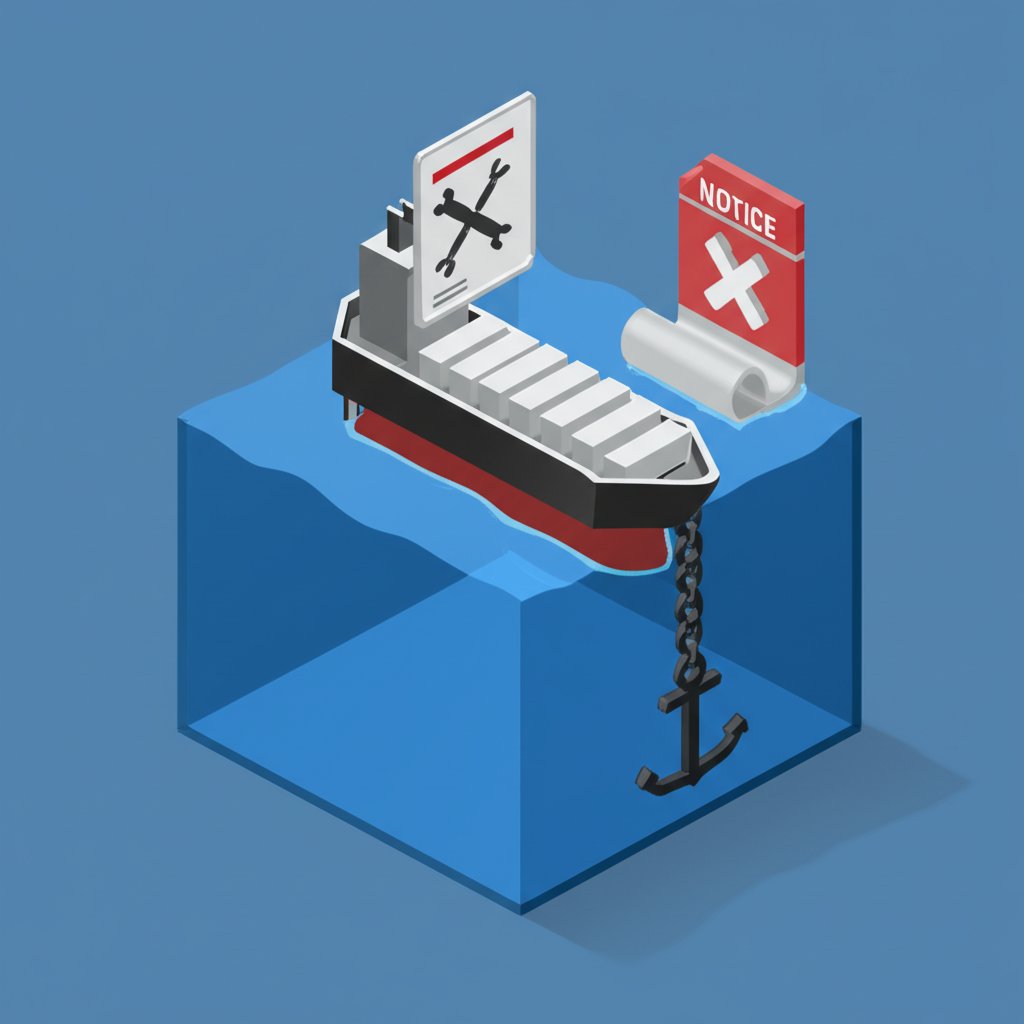In the vast and ever-moving world of global maritime commerce, financial stability is the bedrock of every successful operation. Yet, this intricate ecosystem is not immune to the disruptive force of maritime debt. Whether stemming from unpaid invoices for essential services, a critical breach of contract by a charterer, or other unforeseen financial disputes, these challenges can rapidly jeopardize a company’s solvency and operational continuity. Navigating such waters requires not just vigilance, but also a profound understanding of legal recourse.
One of the most potent and strategically astute initial steps to protect your interests and compel resolution is the issuance of a Notice of Intent to File a Vessel Lien. This powerful document, often interchangeably referred to as a “letter of intent to file a vessel lien,” acts as a formal declaration, signaling your serious intent to leverage the unique enforcement mechanisms available under admiralty law. It’s a proactive measure designed to prompt swift payment, open negotiation channels, and, ideally, prevent the escalation into costly and time-consuming litigation over vessel liens.
This comprehensive guide delves into the genesis and implications of maritime debt, the intricacies of vessel liens, and provides an unparalleled blueprint for effectively deploying a Notice of Intent to File a Vessel Lien to secure your financial claims. We’ll equip you with the world-class expertise needed to navigate these complex legal currents, safeguard your assets, and ensure disputes don’t capsize your business.
Understanding Maritime Debt and the Power of Vessel Liens

At the heart of many disputes in maritime commerce lies maritime debt – an outstanding financial obligation arising specifically from operations or transactions involving vessels. When these debts go unsettled, the legal landscape offers a unique and powerful remedy: the vessel lien.
What Constitutes Maritime Debt? Common Triggers
Maritime debt can originate from a multitude of activities crucial to a vessel’s operation, maintenance, and voyages. Recognizing these triggers is the first step in protecting your interests:
- Unpaid Invoices for Necessaries: This is perhaps the most common source. “Necessaries” is a broad term encompassing goods and services essential for a vessel’s continued operation. This includes, but is not limited to:
- Fuel (bunkers) and lubricants
- Provisions and supplies for the crew and passengers
- Repairs, parts, and maintenance services
- Pilotage, tug services, and stevedoring
- Port charges, wharfage fees, and agency services
- Dry docking and marine railway services
- Surveys and inspections
- Breach of Contract (Charter Party Agreements): Failures to adhere to the terms of a charter party, such as unpaid charter hire, damages for off-hire periods, or breach of warranties regarding the vessel’s condition, are significant sources of maritime debt.
- Unpaid Crew Wages: Seafarers hold a special, almost sacred, status under maritime law. Unpaid wages are considered a “superpriority” lien, often taking precedence over nearly all other claims against a vessel.
- Collision Damages: When one vessel causes damage or loss to another vessel, cargo, or property through a collision, the offending vessel can be subject to a lien for the resulting damages.
- Salvage Remuneration: Services rendered to rescue a vessel or cargo from peril at sea (salvage operations) create a lien against the salvaged property for a fair reward.
- General Average Contributions: In situations where extraordinary sacrifices or expenses are voluntarily incurred to save the entire maritime venture (vessel, cargo, freight) from impending peril, all parties benefiting must contribute proportionally. Unpaid contributions constitute maritime debt.
- Cargo Damage/Loss: In certain circumstances, if freight is owed to a carrier and the cargo owner fails to pay, a lien can arise. Conversely, if the vessel is responsible for damage or loss to cargo, a lien might be asserted by the cargo owner.
The Distinctive Nature of Vessel Liens in Admiralty Law
Vessel liens, also known as maritime liens, are not merely ordinary property liens. They are enshrined in centuries of admiralty law and possess unique characteristics that demand specialized understanding:
- In Rem Jurisdiction: Unlike most land-based lawsuits filed against a person or company (in personam), a maritime lien allows a creditor to directly sue the vessel itself (in rem). This means the claim attaches to the ship, regardless of changes in ownership, and the vessel can be arrested and sold to satisfy the debt. The legal fiction is that the vessel itself is the wrongdoer.
- “Secret” Liens: Perhaps the most striking feature is that many maritime liens arise automatically by operation of law the moment the claim accrues, without any public filing or registration requirement. This means a vessel could carry a multitude of undisclosed liens, posing significant risk for prospective buyers or lenders.
- No Physical Possession Required: A lienholder generally does not need to be in physical possession of the vessel to assert their claim, simplifying the process compared to many common law possessory liens.
- Priority of Liens (“Last in Time, First in Right”): Maritime law has a complex and often counterintuitive system for determining the priority of competing liens, which dictates who gets paid first from the proceeds of a vessel sale. While exceptions exist (e.g., crew wages and salvage often hold “superpriority”), a common principle, especially for “necessaries,” is “last in time, first in right.” This means the most recent suppliers and service providers may have a higher priority than earlier ones.
- International Reach: A maritime lien “travels with the ship” across international borders. This global reach means a lien can potentially be enforced wherever the vessel can be found, making international legal counsel indispensable.
- The Federal Maritime Lien Act (FMLA): In the United States, the FMLA (46 U.S.C. § 31341 et seq.) provides a statutory framework for maritime liens for “necessaries.” It simplifies the creation of such liens, generally eliminating the need to prove the supplier extended credit to the vessel owner, assuming the supplier provided services or goods to the vessel.
Key Players and Their Roles in Maritime Debt Disputes
Understanding the ecosystem of maritime commerce helps contextualize the interplay of parties in maritime debt situations:
- Vessel Owner: The legal entity or individual holding title to the vessel. Ultimately responsible for the vessel’s debts.
- Vessel Operator/Manager: May manage the day-to-day operations, including procurement of supplies and services.
- Charterers: Parties who lease a vessel for a specific period (time charter) or voyage (voyage charter). They may incur debts for bunkers, port fees, etc., that can give rise to a lien against the vessel.
- Suppliers/Creditors: Companies providing “necessaries” – fuel, repairs, provisions, port services, etc. – who are the primary claimants for vessel liens for unpaid invoices.
- Crew/Seafarers: Individuals working on the vessel, whose wages are a paramount concern.
- P&I Clubs (Protection & Indemnity Clubs): Mutual insurance associations providing third-party liability coverage to shipowners, often stepping in to provide security to release an arrested vessel.
The Strategic Imperative: Issuing a Notice of Intent to File a Vessel Lien
Before embarking on the potentially arduous path of vessel arrest and judicial sale, the Notice of Intent to File a Vessel Lien stands as an exceptionally effective preliminary maneuver. It’s often the pivotal non-judicial step that can de-escalate a burgeoning maritime debt dispute and achieve resolution without full-blown litigation.
Beyond a Warning: The Multi-faceted Benefits of the Notice
A letter of intent to file a vessel lien is far more than a mere threat; it’s a strategically crafted legal communication designed to achieve several critical objectives:
- Prompting Payment and Resolution: The most immediate and desired outcome is to compel the debtor to settle unpaid invoices or rectify the breach of contract. No vessel owner wants their valuable asset, the very heart of their operations, to be arrested. The formal threat of a lien and potential seizure is a powerful incentive for payment.
- Opening Negotiation Channels: A formal notice clearly signals your seriousness and intent to preserve your rights. This often brings reluctant or evasive parties to the negotiation table, creating an opportunity for an amicable settlement, which is almost always less costly and faster than litigation.
- Strengthening Your Legal Position: Should litigation become inevitable, having issued a clear Notice of Intent to File a Vessel Lien demonstrates your good faith efforts to resolve the dispute non-judicially. It builds a clear, documented record of your claim, your demands, and the debtor’s failure to respond, which can be highly advantageous in court.
- Clarity and Documentation: The notice formalizes the debt. It clearly outlines the exact amount owed, the basis of the claim, and the consequences of non-payment, leaving no room for ambiguity or future disputes over the specifics of the maritime debt.
- Mitigating Further Losses: By signaling your intent early, you might prevent the vessel from leaving the jurisdiction or the debtor from dissipating assets, making future enforcement more challenging.
When to Deploy the Notice: Optimal Timing and Circumstances
Deciding when to send a Notice of Intent to File a Vessel Lien requires careful strategic consideration. It’s typically employed after initial, less formal attempts to collect maritime debts have been unsuccessful.
Consider these scenarios for optimal deployment:
- Persistent Unpaid Invoices: When invoices for substantial services or goods (e.g., repairs, bunkering, provisions, tug services) remain unpaid beyond their due date, despite multiple friendly reminders and follow-ups.
- Clear Breach of Contract: If a charterer or vessel owner fails to meet critical contractual obligations, such as consistent payment of charter fees, adherence to maintenance schedules, or fulfillment of delivery terms, directly leading to financial loss.
- Unresponsive or Evading Debtor: When the responsible party becomes unresponsive to communication, or actively avoids discussions about maritime debts, indicating a lack of intent to settle.
- Vessel Preparing to Depart: If there’s a credible risk the vessel might leave the jurisdiction, making future enforcement of a vessel lien difficult or requiring more complex international legal actions. The notice can serve as a final demand before seeking an immediate arrest.
- Approaching “Laches” or Statute of Limitations: While maritime liens don’t always have a fixed statute of limitations like other claims, the doctrine of laches (unreasonable delay in asserting a right, which prejudices the other party) can apply. Sending a notice demonstrates prompt action.
- High-Value Claims: For significant maritime debts, a formal notice is a necessary step to underscore the seriousness of the situation.
Expert Insight: Timing is paramount. Sending the notice too early might be perceived as overly aggressive, potentially hindering constructive negotiation. Conversely, waiting too long risks the vessel departing or the debtor’s financial situation deteriorating, complicating recovery. Consulting a seasoned maritime attorney to determine the optimal moment is always advisable.
Differentiating the Notice from an Actual Lien Filing
It’s crucial to understand that a Notice of Intent to File a Vessel Lien is not the same as actually filing a vessel lien or initiating a lawsuit.
- Notice of Intent: This is a pre-litigation communication. It’s a formal warning letter, a declaration of intent. It does not, by itself, create a judicial lien, nor does it typically require court involvement. Its power lies in its deterrent effect and its ability to open dialogue.
- Actual Vessel Lien Filing (Judicial Action): This involves filing a formal verified complaint in a federal admiralty court (in the U.S.) and requesting a warrant for the vessel’s arrest. This is a judicial process that leads to the seizure of the vessel and, if the debt remains unpaid, its eventual judicial sale.
While a notice isn’t always a mandatory legal prerequisite for lien filing under the Federal Maritime Lien Act, its strategic value in resolving maritime debts before costly court intervention is undeniable.
Crafting an Ironclad Notice of Intent: Components, Due Diligence, and Documentation
The efficacy of your letter of intent to file a vessel lien relies entirely on its precision, clarity, and legal robustness. A vague, incomplete, or improperly drafted notice can easily be dismissed by the debtor or, worse, weaken your legal standing if the matter progresses to court.
Essential Components for Legal Validity and Impact
To maximize its persuasive power and legal defensibility, your Notice of Intent to File a Vessel Lien must include the following critical elements:
- Clear Identification of the Vessel:
- Full and Accurate Vessel Name: Exactly as it appears on official registers.
- Unique Identifiers: IMO number, Official Number, Call Sign, MMSI number. These are crucial for unambiguous identification.
- Flag State: The country of registration.
- Current or Last Known Location: (e.g., “currently believed to be in port of Houston, Texas” or “last known port of call was Singapore”).
- Accurate Identification of Parties:
- Lien Claimant: Full legal name of your company or individual, with complete contact information (address, phone, email).
- Vessel Owner(s) and/or Operator(s): Full legal name(s) and contact information. Research is vital to identify the correct legal entity.
- Registered Agent for Service of Process: If known, include this, as they are legally authorized to receive notices.
- Detailed Basis of the Claim: This is where you explain the maritime debt.
- Comprehensive Description of Goods/Services: Be specific. Instead of “repairs,” state “main engine overhaul, including replacement of XYZ parts.”
- Specific Dates: When services were performed, or goods supplied (start and end dates).
- References to Contracts/Purchase Orders: Cite the specific agreement(s) that govern the transaction.
- Clear Explanation of Lien Basis: Articulate how these goods/services constitute “necessaries” or another valid basis for a maritime lien under applicable law (e.g., FMLA provision for bunkering).
- Reference to Unpaid Invoices: List specific invoice numbers and dates.
- Precise Amount Due:
- Exact Principal Amount: The outstanding maritime debt.
- Accrued Interest and Late Fees: Clearly state the contractual basis for interest (e.g., “1.5% per month as per Clause 7 of the Supply Contract dated…”) and late fees.
- Itemized Breakdown: Reference specific invoices or show a clear calculation of the total amount.
- Explicit Demand for Payment and Deadline:
- Unambiguous Demand: “Demand is hereby made for immediate payment of the full outstanding amount…”
- Reasonable, Yet Firm, Deadline: (e.g., “Payment must be received in full within seven (7) calendar days from the date of this notice”). This period must be realistic for the debtor to act.
- Clear Statement of Consequences:
- Unequivocal Intent: State that if payment is not received by the deadline, you will proceed with filing a vessel lien against the named vessel in the appropriate federal court.
- Potential Actions: Explicitly mention the potential for vessel arrest, judicial sale, and the pursuit of all available legal remedies to recover the debt.
- Additional Costs: Clearly state that any and all costs, including legal fees, court costs, and marshal’s fees incurred in the enforcement process, will be sought from the debtor and/or the vessel.
- Jurisdictional Information (Optional but Powerful):
- While not strictly required in the notice itself, indicating your understanding of the relevant U.S. federal admiralty jurisdiction (e.g., “pursuant to the Federal Maritime Lien Act (46 U.S.C. § 31341 et seq.) and Rule C of the Supplemental Rules for Admiralty or Maritime Claims…”) adds gravitas and demonstrates legal preparedness.
The Critical Role of Comprehensive Documentation
The strength of your letter of intent to file a vessel lien and any subsequent legal action rests entirely on the quality and completeness of your supporting documentation. Meticulous record-keeping is not merely good business practice; it’s a legal imperative in maritime commerce.
Ensure you have readily accessible:
- Signed Contracts/Agreements: All relevant contracts (charter parties, supply agreements, service contracts) that clearly outline terms, scope of work, and payment schedules.
- Invoices: Detailed, itemized, and dated invoices for all goods and services provided, showing the outstanding balance and any applied interest/late fees.
- Proof of Delivery/Service: Bills of lading, delivery receipts, bunker delivery notes, signed work orders, service reports, or other documentation confirming the provision of goods or completion of services to the specific vessel.
- Communication Logs: A meticulous record of all correspondence (emails, letters, faxes, meeting minutes, phone call summaries) related to the debt, payment reminders, and collection attempts. This demonstrates your efforts to resolve the maritime debt amicably.
- Wage Statements/Crew Agreements: For crew wage claims, copies of employment contracts, payroll records, and any agreements regarding repatriation.
- Certifications/Surveys: Any relevant survey reports, certifications, or regulatory documents if the claim relates to vessel condition or compliance.
These documents form the undeniable evidentiary foundation of your claim and will be indispensable if the matter proceeds to court after your Notice of Intent to File a Vessel Lien.
Due Diligence Before Drafting: Verifying Claims and Vessel Information
Before drafting and dispatching your notice, a crucial step involves conducting thorough due diligence to verify the accuracy and strength of your claim:
- Confirm Debt Accuracy: Double-check all calculations, ensuring the exact amount owed is correct and justifiable according to your records and contract terms.
- Verify Vessel Identity: Ensure all identifiers (IMO, Official Number) are correct for the specific vessel against which you intend to assert the lien. Mistakes here can complicate or invalidate your claim.
- Identify Correct Parties: Confirm the latest registered owner, bareboat charterer, and any known operators of the vessel. Ownership can change, so recent registry checks are vital.
- Review Contractual Terms: Re-read your contracts for any clauses that might affect your right to lien (e.g., “no lien” clauses, arbitration clauses, specific notice requirements). While “no lien” clauses are generally not enforceable against third-party suppliers of necessaries under the FMLA, it’s essential to be aware of them.
Navigating Proper Service and Strategic Next Steps
Issuing a Notice of Intent to File a Vessel Lien is only effective if it’s properly delivered and strategically followed up. Improper service can invalidate your efforts, diminish the notice’s impact, and delay the recovery of your maritime debts.
Ensuring Valid Service: Legal Requirements and Best Practices
Serving the letter of intent to file a vessel lien is a formal process, not merely sending an informal email. To ensure its legal validity and impact, especially if it becomes evidence in court:
- Consult with a Maritime Law Expert: This cannot be overstressed. Before finalizing or serving any notice, engage an experienced maritime attorney. They will:
- Advise on specific jurisdictional requirements and legal nuances for vessel liens.
- Ensure the notice adheres to all applicable legal standards.
- Strategize the most effective methods of service for your specific situation and the vessel’s location.
- Review the claim’s merits and supporting documentation.
- Method of Service: The notice must be served in a manner that provides undeniable proof of receipt. Common and legally sound methods include:
- Certified Mail with Return Receipt Requested (or equivalent international service): This provides a mailing receipt and electronic or physical verification of delivery or attempted delivery. It’s a widely accepted method for formal notices.
- Personal Service by a Professional Process Server: A professional process server can personally deliver the notice to the vessel owner, their registered agent, or even the vessel’s master (captain) if authorized. They provide an affidavit of service, which is strong legal proof.
- Reputable International Courier Services with Delivery Confirmation: Services like FedEx or DHL that offer detailed tracking and signature confirmation are often used for international service.
- Fax/Email (with follow-up): While less formal, if specifically agreed upon in a contract or if traditional methods are impractical, these can be used, but always follow up with a physical, trackable delivery method. Obtain read receipts or delivery confirmations.
- To Whom to Serve: Serve the notice to all relevant parties to maximize its impact and ensure legal notification:
- The Vessel Owner(s): The primary target.
- The Vessel Operator(s) (if different from the owner): They may have operational control and be responsible for the debt.
- The Registered Agent for Service of Process: If the owner/operator has a designated legal agent, this is a highly effective point of service.
- The Vessel’s Master (Captain): If direct service on the owner or agent is impractical, service on the master may be considered valid, especially if the master is authorized to receive legal documents for the vessel.
- Documentation Retention: Maintain meticulous records of the entire service process. This includes:
- Copies of the signed Notice of Intent to File a Vessel Lien.
- All related supporting documentation.
- Postage receipts, certified mail receipts, return receipts.
- Delivery confirmations from couriers.
- Affidavits of service from process servers.
- Any email or fax confirmations.
These carefully retained records are invaluable as proof of your due diligence and proper legal procedure should the matter proceed to court to enforce vessel liens.
Potential Responses to Your Notice
Once the Notice of Intent to File a Vessel Lien has been properly served, several outcomes are possible, each requiring a tailored response:
- Prompt Payment and Resolution: The ideal scenario. The vessel owner acknowledges the maritime debt and proceeds to pay the outstanding unpaid invoices or rectify the breach of contract by the stipulated deadline. This leads to an amicable resolution, avoiding the need for a formal vessel lien filing.
- Negotiation and Settlement Offer: The owner may respond by initiating negotiations, perhaps offering a partial payment, a payment plan, or proposing an alternative resolution. Your legal counsel can help you evaluate and formalize any settlement agreement, including drafting a release of potential lien claims once the terms are met.
- Failure to Respond: If the deadline passes without payment or a good faith response, you are then in a strong position to proceed with filing a formal vessel lien in federal court, often involving seeking a warrant for the vessel’s arrest. This signifies the end of the pre-litigation phase for maritime debts.
- Dispute of Claim: The owner may dispute the validity or amount of the claim, presenting counter-arguments or alleging deficiencies in your service or goods. This requires careful legal evaluation and potentially further negotiation, evidence gathering, or preparation for litigation.
The Decision Point: Proceeding to Formal Vessel Lien Filing
If the Notice of Intent to File a Vessel Lien fails to secure payment or an acceptable resolution by the deadline, the next critical decision involves proceeding with formal legal action. This is the point where the strategic tool transitions into judicial enforcement.
This decision should always be made in close consultation with your maritime attorney, weighing the potential costs of litigation against the likelihood of recovery, other available assets of the debtor, and the specific circumstances of the maritime debt.
Enforcing Your Vessel Lien: The Complexities of Judicial Action

If your Notice of Intent to File a Vessel Lien does not yield a satisfactory resolution of your maritime debts, the next logical, though more complex, step is to enforce the vessel lien through the judicial system. This specialized area of federal admiralty law demands the expertise of seasoned maritime legal counsel.
Initiating an In Rem Action: Federal Court Procedures
The enforcement of a vessel lien typically falls under federal admiralty jurisdiction in the United States. The lienholder must initiate an in rem action by filing a verified complaint in the appropriate U.S. federal district court. This complaint is unique because it names the vessel itself as the defendant, often appearing as, for example, “Claimant Co. v. M/V SEA FORTUNE, her engines, tackle, appurtenances, etc.“
The complaint must meticulously set forth:
- Identification of the Vessel: As detailed in your initial notice (name, IMO number, flag).
- Nature of the Claim: A clear explanation of the maritime debt (e.g., unpaid invoices for “necessaries” under the FMLA, breach of contract for charter hire, unpaid crew wages).
- Specific Amount Owed: The exact principal sum, plus any accrued interest, late fees, and anticipated costs.
- Allegation of Maritime Lien: A statement that a valid maritime lien has arisen and exists against the vessel.
- Request for Vessel Arrest: A formal request to the court to issue a warrant for the vessel’s arrest.
The Process of Vessel Arrest and Substitute Security
- Obtaining a Warrant of Arrest: Upon reviewing the verified complaint and supporting affidavits from the lien claimant, a federal judge may issue a warrant for the arrest of the vessel.
- Execution by U.S. Marshals: The U.S. Marshals Service is responsible for executing the warrant. They will proceed to the vessel’s location (e.g., port, shipyard, anchorage) and formally seize it. Once arrested, the vessel is in the custody of the court and is legally prohibited from moving.
- Public Notice: After the arrest, public notice of the vessel’s seizure is published, typically in a newspaper of general circulation in the district where the vessel is arrested. This serves to notify any other potential lienholders or interested parties, allowing them to assert their own claims against the vessel, which will be consolidated in the same action.
- Substitute Security (Bond): To secure the vessel’s release from arrest and allow it to resume operations (as prolonged arrest can be ruinous), the owner, charterer, or an interested third party (like a P&I Club) will typically post a bond or other form of security with the court. This security is usually sufficient to cover the amount of the lienholder’s claim, plus interest, costs, and often a buffer for potential legal fees. Once adequate security is posted, the vessel is released, and the in rem action proceeds against the substitute security.
Judicial Sale and Priority of Claims
If the lienholder’s claim is successful in court and no bond is posted or settlement is reached, the court may order the vessel to be sold at a public auction.










